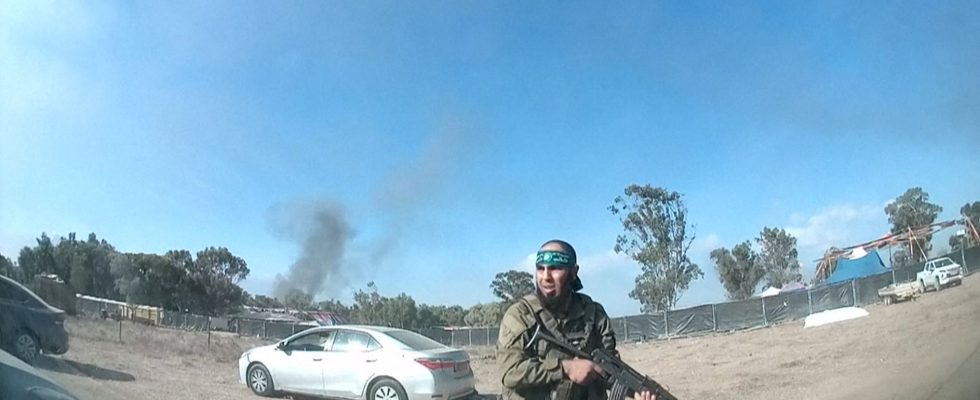War also involves images. Saturday October 7, the large-scale military operation launched from the Gaza Strip by Hamas against Israel is not only taking place on the ground. In the hours following the infiltration of the armed organization, several extremely violent videos circulated on social networks.
We see civilians taken hostage, taken by force and brutalized in the Gaza Strip. One video, in particular, was particularly shared: that of a half-naked young woman – who was identified by those close to her as an Israeli-German citizen – unconscious (or dead) in the back of a pick-up loaded with soldiers from the Islamist organization. Around her, her tormentors seem galvanized. Despite European directives on the platform moderation policy, content management on X (formerly Twitter) still seems uncertain since the purchase of the platform by Elon Musk. Widely shared, accompanied by messages of indignation – or congratulations, in some cases – these videos could later be used as evidence of war crimes, indicates Amélie Férey, coordinator of the defense research laboratory at the Center for Defense Studies. security of Ifri.
L’Express: Since the start of Hamas’s military offensive against Israel, social networks have been overwhelmed by a flood of images of rare violence. How can we explain this omnipresence of the image in the conflict?
Amélie Férey: In this conflict, communication strategy is very important, both on the Hamas side and on the Israeli side. And for a long time: the media environment and the stories around the operations were seized by the IDF, the Israeli army, around the years 2005-2007. Communication has become an integral element of the strategy to be deployed. The IDF has also become one of the first armies to do live broadcasts on Twitter on current operations and videos to win the battle for legitimacy. The idea here is that explaining Israel’s position prevents criticism.
Hamas adapted very quickly by investing in this area. On Telegram, in particular, many videos are circulating from the channel of the Al-Qassam brigades – the armed wing of Hamas. Its members broadcast fairly well-edited videos of fairly good quality, produced to win the battle for legitimacy.
In the case of Hamas, unlike the IDF, we are not in a strategy of explanation, but in an idea of regaining a form of psychological ascendancy. The objective is to show that, despite the absence of military equipment, high technology and a state army, the organization manages to carry out large-scale operations. Hamas intends to communicate that it is a first-rate military actor, endowed with military capabilities that can make Israel tremble, while winning the war of moral forces: it wants to persuade that it is capable of winning against the enemy. Unlike other wars, such as that taking place in Yemen, the Israeli-Palestinian conflict has long been a war of images. Social media is used as a weapon. The multiplication of videos, for example, of rockets hitting their target, will have an effect on the moral forces of the opposing camp and on its determination.
Images of extreme violence circulating since Saturday – particularly civilians suffering abuse – Are they part of the terrorist organization’s strategy?
It is imperative to distinguish the different types of videos broadcast. Until now, there are videos of rockets being launched, where we see the destruction of tanks and sensors on the Gaza border. The second type of videos is that where we see the bodies of Israeli soldiers and civilians against whom violence is carried out. These images seem to come from Gazans, who, using their phones, are filming without there necessarily being any communication strategy on the part of Hamas.
They contribute to the flood of images broadcast on the conflict, but are proof that this sword can be double-edged and can turn against its transmitter. In this case, the videos of fighters trampling an Israeli soldier outrage and accuse the action of Hamas. These images are probably not controlled by the Al-Qassam brigades, and are more of an individual initiative.
How can we explain, in this case, the considerable number of videos taken by civilians?
The use of social networks in the Israeli-Palestinian conflict is not new. In 2021, the platforms were used so much that there was talk of a “TikTok Intifada”. One of the novelties of today’s war is that everyone with a cell phone can amplify actions and have an impact on the belligerents. The moral question is an instrument of the balance of power, since we can denounce abuses and unjust behavior. This is what Gazans have been able to do in the past. It all depends on the digital culture of the populations present and their connectivity. Israel is an extremely connected country, where the digital culture is very strong. This is also the case for Hamas and the Palestinians. The use of videos in the conflict has been mastered by the different parties to the conflict for a long time.
However, these videos show extremely shocking content. Some have nevertheless justified Hamas’ attack against Israel, citing in particular the occupation of Palestinian territories.
Do not mix everything up. There is the question of the violence of a video, on the one hand, and that of its interpretation, on the other hand. When we see videos of war crimes, where abuses are committed with bodies being violated and dragged to the ground, the effect obtained is more chilling than anything else. They play against Hamas, which also has rather controlled communication on its official accounts, wanting to highlight the professionalism of its armed groups.
These images risk having consequences: they can also be used in the context of international criminal proceedings as evidence of war crimes. This is, for example, what happens in the context of videos of abuses made by Russians in Ukrainian territory, which are then collected by NGOs in order to compile cases for the International Criminal Court.
